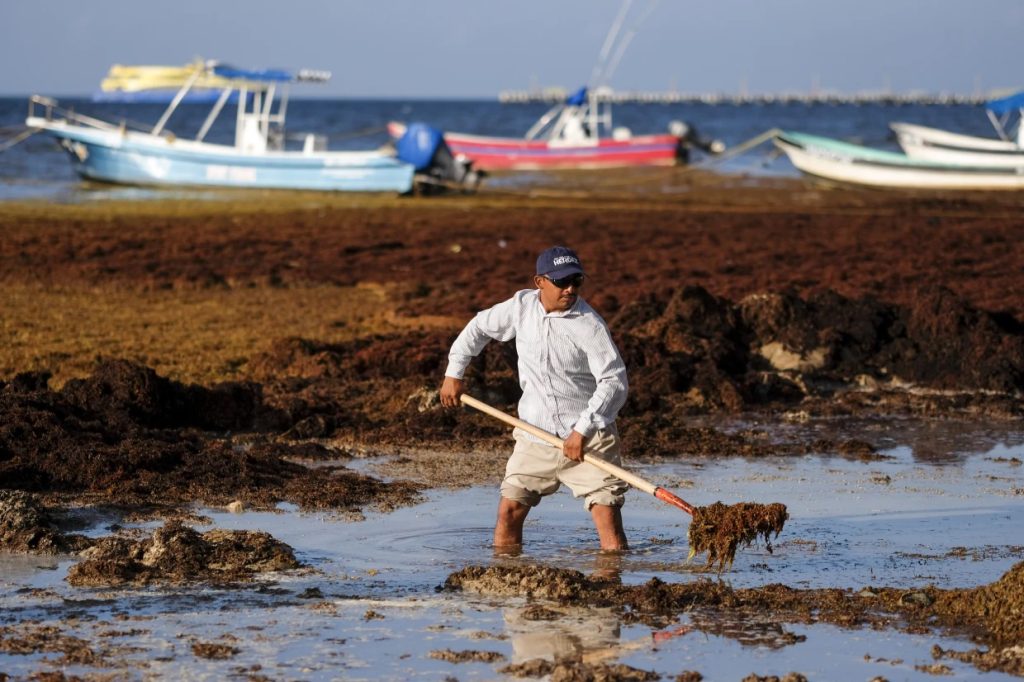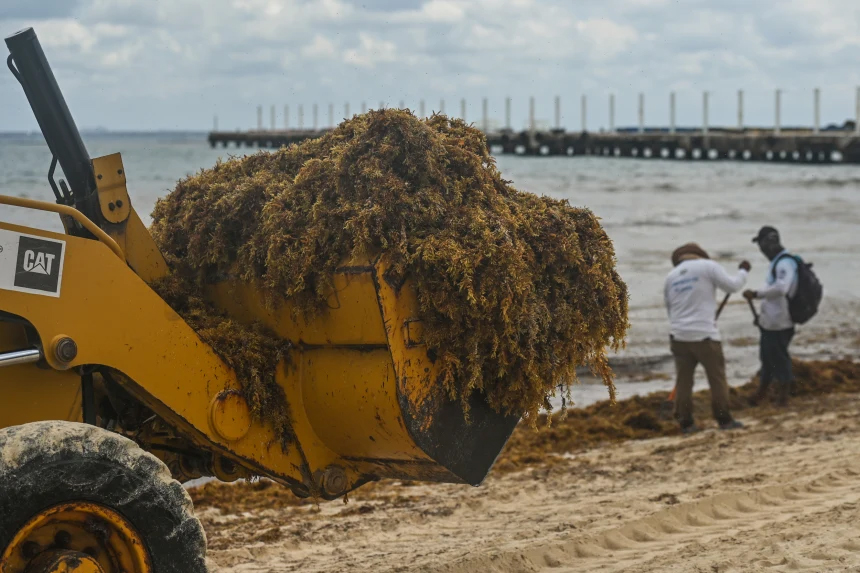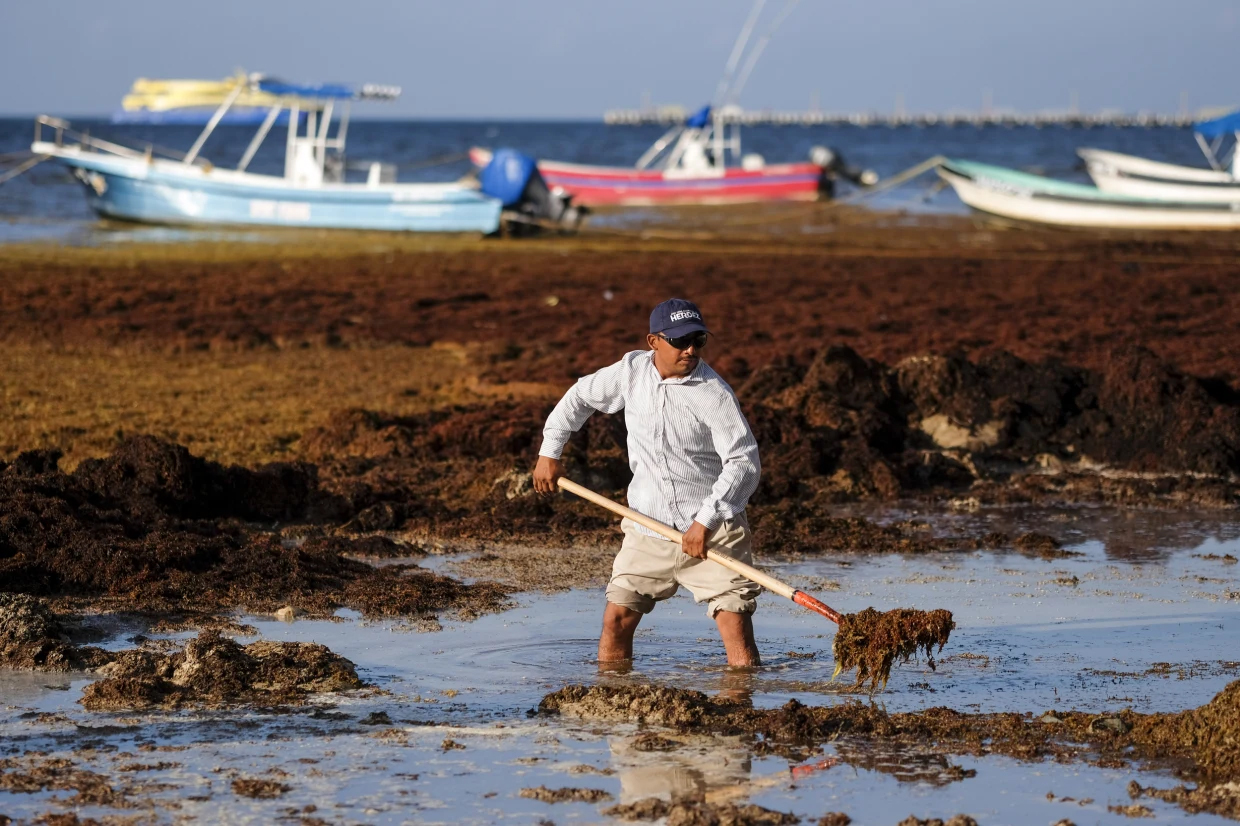Originally posted: 3/11/2023 | Article Courtesy: nbcnews.com | Please click here for original article.
By
Seasonal sargassum blooms have exploded in the tropical Atlantic over the past decade and more. This year’s is already staggeringly large.

Above: A worker removes sargassum seaweed from the shore of Playa del Carmen, Mexico, in 2019. Photo: Victor Ruiz / AP file
A raft of brown-colored seaweed in the Atlantic Ocean is so vast it can be seen from space.
Spanning roughly 5,000 miles — about twice the width of the United States — the thick blanket of sargassum floats between the Gulf of Mexico and the shores of West Africa.
In open water, these giant mats of algae are mostly harmless and even have some benefits, including serving as a habitat for certain fish and crustaceans and absorbing carbon dioxide. But ocean currents are pushing sargassum west, causing hundreds of tons of seaweed to wash up on beaches across the Caribbean and Gulf of Mexico.
There, it can choke corals, wreak havoc on coastal ecosystems and diminish water and air quality as it rots.
Scientists say this bloom is one of the largest on record, stoking fears that seaweed invasions of beaches in the coming weeks and months could be particularly severe.
“It’s incredible,” said Brian LaPointe, a research professor at Florida Atlantic University’s Harbor Branch Oceanographic Institute. “What we’re seeing in the satellite imagery does not bode well for a clean beach year.”
Sargassum’s growth varies from season to season. LaPointe, who has studied it for four decades, said huge piles typically come ashore in South Florida in May, but beaches in Key West are already being inundated with algae. Parts of Mexico’s Yucatán Peninsula, including Cancun, Playa del Carmen and Tulum, are preparing for up to 3 feet of sargassum buildup in the coming days.
Giant mounds of sargassum are more than a nuisance and an eyesore, said Brian Barnes, an assistant research professor at the University of South Florida’s College of Marine Science.
“Even if it’s just out in coastal waters, it can block intake valves for things like power plants or desalination plants, marinas can get completely inundated and boats can’t navigate through,” he said. “It can really threaten critical infrastructure.”
Last summer, the U.S. Virgin Islands declared a state of emergency after unusually high quantities of sargassum caused water shortages on St. Croix.
Other impacts to human health are coming into focus. As the seaweed rots, it releases hydrogen sulfide, which can cause respiratory problems for tourists and residents in the vicinity, LaPointe said.
“Following the big 2018 blooms, doctors in Martinique and Guadeloupe reported thousands of people going to clinics with breathing complications from the air that was coming off these rotting piles of sargassum,” he said.
Then there are the economic concerns. Sargassum invasions can stifle tourism, and removing hundreds of tons of algae from beaches is costly.

Above: Cleanup crews remove sargassum seaweed from Playa del Carmen, Mexico, on April 29, 2022. Photo: Artur Widak / NurPhoto via Getty Images file
Scientists noticed more than a decade ago that sargassum blooms were beginning to grow at staggering rates. Researchers have since documented the algae’s proliferation in the tropical Atlantic.
“Before 2011, it was there but we couldn’t observe it with satellites because it wasn’t dense enough,” Barnes said. “Since then, it has just exploded and we now see these huge aggregations.”
A 2019 study in the journal Science estimated that more than 20 million metric tons of sargassum blanketed the Atlantic in what has been nicknamed the “Great Atlantic Sargassum Belt.”
Barnes said the mass of seaweed appears to be increasing each year, but 2018 and 2022 had the largest accumulations. This year is approaching those records, he added.
In investigating the factors driving this dramatic growth in sargassum, scientists, including LaPointe, have found that human activities and climate change are seeding rivers that flow into the Atlantic with nitrogen and other nutrients. That then feeds the algae blooms.
“You have the Congo, the Amazon, the Orinoco, the Mississippi — the largest rivers on the planet, which have been affected by things like deforestation, increasing fertilizer use and burning biomass,” LaPointe said. “All of that is increasing the nitrogen concentrations in these rivers and so we’re now seeing these blooms as kind of a manifestation of the changing nutrient cycles on our planet.”
Many of these effects are exacerbated by climate change, he said, which can increase flooding and runoff into major waterways.
Typically, floating rafts of sargassum accumulate in a part of the North Atlantic called the Sargasso Sea. The Gulf Stream shuttles the plants around the Atlantic basin, which allows the seaweed to spread and take hold in different parts of the ocean.
Barnes and his University of South Florida colleagues use NASA satellite data to map the Great Atlantic Sargassum Belt and its movements. The bloom’s size in recent years would have been inconceivable decades ago, he said.
“Historically, as far back as we have records, sargassum has been a part of the ecosystem, but the scale now is just so much bigger,” Barnes said. “What we would have thought was a major bloom five years ago is no longer even a blip.”






